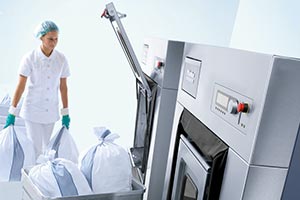Inspirational social care leader Zoë Fry has been awarded the Order of the British Empire (OBE) medal for services rendered to social…
Laundry measures for effective infection prevention and control
Having a comprehensive infection prevention control plan in place and ensuring that it’s being stuck to religiously throughout the care home is now more important than ever. Not only will stringent measures ensure hygienic standards, but also prevent the spread of infection and keep vulnerable residents and staff safe in the care environment. A vital part of this is the effective decontamination of linen and the proper and professional reprocessing of laundry. While every care establishment is different depending on its capacity and the type of care it provides and so naturally infection control policies will differ from care home to care home, there are some key factors and regulations that need to be taken into account when defining or revising your laundry procedures.
Standard and enhanced processes
From the moment linen is collected for laundering, it should be segregated appropriately depending on the type of risk that the resident poses; the standard process for ordinary soiled or fouled linen and the enhanced process for infectious linen. It’s important to ensure that your staff are fully briefed on both processes and when they should be used. Personal protective equipment (PPE), such as single-use aprons and gloves, should be used when handling any dirty or soiled linen, and once it has been removed from the resident’s bed it should be placed in the appropriate colour-coded container. This segregation should be carried out before the linen is transported to the laundry. 
Correct equipment and laundry design
The correct equipment and process-led laundry design is a vital factor in ensuring effective infection prevention and control. Firstly, it’s important to calculate the machine capacity required to ensure you have the right equipment to cater for the volume of laundry produced. We normally work on the assumption that a standard residential care home will need to allow for 0.5kg of laundry per resident, per hour, while for a nursing home this increases from anything from 0.6kg to 0.75kg.
The machines you’re using should be professionally installed and maintained commercial models that can provide the optimum wash cycle times and temperatures, and when paired with specialist detergent, the agitation of laundry required to kill infectious diseases. The Department of Health’s Health Technical Memorandum 01-04 defines that washing should be held at either 71 degrees for at least three minutes, or 65 degrees for at least 10 minutes, for effective thermal decontamination to take place. All machines also need to be compliant with the Water Regulatory Advisory Scheme (WRAS) category 5 to prevent the mains water supply becoming contaminated from potentially hazardous or infectious waste.
Well-considered laundry design can also help to ensure maximum infection prevention and control. Having a clear ‘dirty to clean’ flow, from washers, to dryers, to ironers to storage, helps ensure that there is enough room to manage all the laundry required and minimises the risk of recontamination. Clean linen should always be kept entirely separate from dirty items throughout the laundry process and stored in a clean area off the floor.
You should also take the use of PPE into consideration with laundry design. Carefully consider all the activities and instances where this may be necessary and ensure that the correct dispensing and disposal equipment is easily accessible in the right locations. The same goes for handwashing facilities; hand wash basins, liquid soap, disposable paper towels and pedal-operated waste receptacles should be located at convenient points to be easily accessed by staff. While it may sound like a very obvious consideration, clean hands are the single most important factor for preventing the spread of infection and can ensure that harmful germs and micro-organisms are not being transferred to other people, equipment or surfaces.
Responsibilities
While everyone involved in the laundry process is responsible and accountable, it can be incredibly beneficial to remind managers and staff of their responsibilities so you can ensure the entire team is correctly fulfilling their requirements.
Managers have a responsibility to ensure that all staff have the necessary knowledge to protect both residents and themselves from the spread of infection. This should be standardised throughout the business and everyone’s knowledge should be refreshed at least once a year. Managers are also responsible for the provision of the correct laundry equipment, including the supply of single use PPC for all staff.
Staff are responsible for the appropriate use of PPE and correct equipment usage. They should be knowledgeable about good hand washing technique and employ it regularly during the working day. They should also have good knowledge about the difference between soiled and infectious linen, and how each should be bagged, handled and processed.
It’s more important now than ever to revise your infection control plan to ensure that it’s thorough and prescriptive enough, and that all staff are familiar with the special precautions and measures they need to be taking to ensure the health and safety of the team and the care home’s residents. The policy should be a part of your company culture and ethos; lived and breathed by all care home staff.





